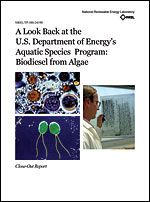|
From Algae to Alternative Energy
IN JANUARY 2009, Continental Airlines completed the first flight of an algae-powered jet. Using a biodiesel blend of two types of alternative oils - algae and jatropha, a weedy plant that produces oil-rich seeds - the 90-minute test flight went off without a hitch.
As the airline industry has come under increasing scrutiny for its contribution to total greenhouse gas emissions — a whopping three percent worldwide, according to the Intergovernmental Panel on Climate Change — startup companies and basic research efforts have ramped up to meet the growing demand for cleaner, greener jet fuels. Many are placing their hopes in fast-growing algae, whose high lipid content can provide the necessary oils for biodiesel blends that can meet the specs of the aviation industry.
More than a dozen companies have sprung up in recent years to harness algae's power for alternative fuel production. In late 2008, Bill Gates and the Rockefeller family made investments totaling more than $100 million in Sapphire Energy, a company in San Diego working toward a commercial-scale facility to produce oil from algae. Another California-based company, Solazyme, recently made headlines for developing a novel fermentation process to produce fuel from algae, without the need to capture energy from the sun.
But despite soaring investments of intellectual and financial capital, the pathway from algae to jet fuel and other biodiesels remains complicated by technological hurdles. The primary obstacle: Coaxing algae to convert sunlight to lipid-rich biomass in such a way that the conversion process becomes cost-effective.
This is not a new problem. During the last major energy crisis, in the 1970s, the federal government made a significant investment in biofuels derived from algae. From 1978 to 1996, the U.S. Department of Energy's Office of Fuels Development funded a program to develop algae-derived renewable transportation fuels. The main focus of this Aquatic Species Program was the production of biodiesel from high lipid-content algae grown in ponds, using waste carbon dioxide from coal-fired power plants.
Although tremendous advances were made in the science of manipulating the metabolism of algae and the engineering of microalgae production systems, cost concerns ultimately shut down the Aquatic Species Program. Analyses concluded that there was little hope for making the algae-to-fuel conversion process cost-efficient and that the constraints were biological, not engineering-related. To be cost-efficient would require near-theoretical levels of conversion efficiency from sunlight to algal biomass — plus the ability to induce algae to maintain a high lipid content, which is not its natural state. Even with such assumptions in place, projected costs for biodiesel remained two times higher than current petroleum diesel fuel costs.
Although the recent surge of interest in biofuels from algae has brought new technologies and new approaches, the same problems remain. Researchers and entrepreneurs are trying new methods for growing algae. Instead of using open ponds where it is challenging to maintain algae at optimum growth rates, they are using photobioreactors, closed triangular chambers made from sheets of polyethylene plastic, which bubble supplemental carbon dioxide through the system. Other researchers are experimenting with biochemical techniques to "trick" the algae into producing more lipid bodies to increase their potential yield for biodiesel.
Ultimately, "the bottom line rests on scale-up costs," according to microbiologist Jennie Hunter-Cevera, president of the University of Maryland Biotechnology Institute. The question remains, she writes in a recent report on next-generation biofuels (see Building Capacity for Biofuels in the Bay), "Can a commercial-scale algae facility produce biodiesel at a cost competitive with petroleum or other biofuel sources?"
Some scientists remain skeptical. The crux of the problem, explains the University of Maryland's Patrick Kangas, is that few species of algae intrinsically contain a high fatty acid content. The only way to get high lipid content in algal cells is to force conditions that cause the cells to make a lot of fatty acid, he explains. One method is to drive the growth rate up by providing a lot of nutrients and then starving them, which sends a metabolic signal to the cell to store fatty acids. People have done this successfully in the lab, but it hasn't worked on a big scale, he says. "I just don't think it is going to work. It is very expensive and it doesn't happen that way out in nature."
Regardless of whether biodiesel from algae can become a cost- and energy-efficient enterprise, investment in algal biofuels still holds great promise. Algae can be used for applications like the Algal Turf Scrubber at sewage treatment plants or in other polluted waters (see River of Opportunity). The algae byproduct of nutrient remediation can be used to produce either biodiesel or other fuels such as ethanol and butanol, which do not require the lipid-rich material for the conversion process. Since algae can grow 20 times faster than most land-based crops and can make use of nutrient-rich wastewater to fuel its growth, it may have a key role to play in the greening of America's energy future.
The success of new startup ventures to produce jet fuel from algae may be years in the making, but algae's promise for alternative energy has already taken flight.
 |
|
Pioneering the first algae-powered air travel, Continental Airlines successfully completed a test flight (shown taking off in early 2009) using a biodiesel blend of oils derived from algae and the jatropha plant. Though algae biodiesel is not yet commercially competitive, the high cost of fossil fuels and determined entrepreneurship have rekindled interest in it, reviving a major area of research once the focus of the U.S. Department of Energy's Aquatic Species Program, as outlined in this 1998 report (right).
Credit: Mark Eichberger, courtesy of Continental Airlines. |
 |
Erica Goldman
|

